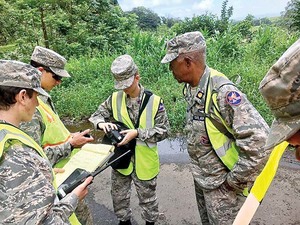Communications Program
Civil Air Patrol Communications Program
The Civil Air Patrol (CAP) radio network operates in support of all three CAP missions: Emergency Services, Aerospace Education and Cadet Program. The focus of the CAP system is tactical communications, including air to ground, ground team to ground team, and communication with mission base, remote bases, and the Incident Command Post (ICP). This radio system is also utilized in relaying urgent traffic for federal, state, and other customers without relying on commercial communications systems that may be unavailable or overloaded. Interoperability with other agencies is stressed. In most cases, a Memorandum of Understanding (MOU) is signed with each agency before operation on each other's frequencies.
CAP's HF/VHF system includes over 1,000 High Frequency (HF) Automatic Link Establishment (HF-ALE) capable base stations, approximately 260 ground vehicle mobile HF units, plus an extensive Very High Frequency (VHF) network with over five hundred 100-watt analog/digital (P25) repeaters, 10,000 of VHF base, mobile and hand-held radios. The CAP system also includes nearly 150 low power portable repeaters for temporary ground or air-mobile use. All equipment operates on federal frequencies assigned to CAP, and is compliant with National Telecommunications Information Administration (NTIA) standards and thus capable of inter-operability with military, federal, and state agencies.
Over 19,000 CAP members are trained in use of these radio systems. Close to 4,500 members are training for or currently hold Incident Command System (ICS) compliant advanced communications qualifications. Many, but by no means all, are amateur radio operators. Using volunteer operators trained to professional standards, the CAP communications network is a ready force for homeland security and the protection of life and property.
CAP's radio systems are well-prepared to provide contingency communications when commercial communications systems become unavailable or overloaded. CAP holds 15 national voice nets a week on multiple HF frequencies averaging close to 120 daily check-ins. All 50 states plus Puerto Rico and the District of Columbia are represented in the national nets. There are many region and state-level HF nets on various schedules. Some areas conduct local VHF nets. CAP also maintains 24/7 duty station watch on a national suite of dedicated ALE frequencies, ready for unscheduled relay of internal and external traffic, and is developing an infrastructure of Mil-Std 188-110 data communications, which will have HF modems installed at all levels of the organization.
Formal traffic is passed daily, with procedures based on meticulous implementation of military ACP-125 procedures. Members use Air Force-assigned tactical call signs, but in inter-agency operation may also use functional designators, in accordance with ICS/NIMS standards and customer needs. Strict operational security is maintained on-the-air.
CAP participates in Department of Defense (DoD) communications exercises, in preparation for actual national emergency taskings. CAP also tests its capabilities via pre-authorized national exercises.
With Air Force funding support, CAP continues today to further strengthen and modernize our tactical communications system. Similarly, many CAP members also choose to purchase their own NTIA-compliant equipment for their use in the CAP communications system. This creates a unique blend of private and organizationally-owned HF and VHF radio equipment, which allows for a fault-tolerant and resilient voice communications network.
Compliant Equipment
CAP National Headquarters assigned some staff and volunteers to evaluate radio equipment in the marketplace and post their findings on a web page for all to see. The resulting database is online and available as a resource not only to CAP and its members, but to other federal and state agencies looking for answers to what they can buy and stay within the boundaries of NTIA rules. Even equipment manufacturers now visit this site to learn how their equipment compares with the rules and the rest of the marketplace.
















